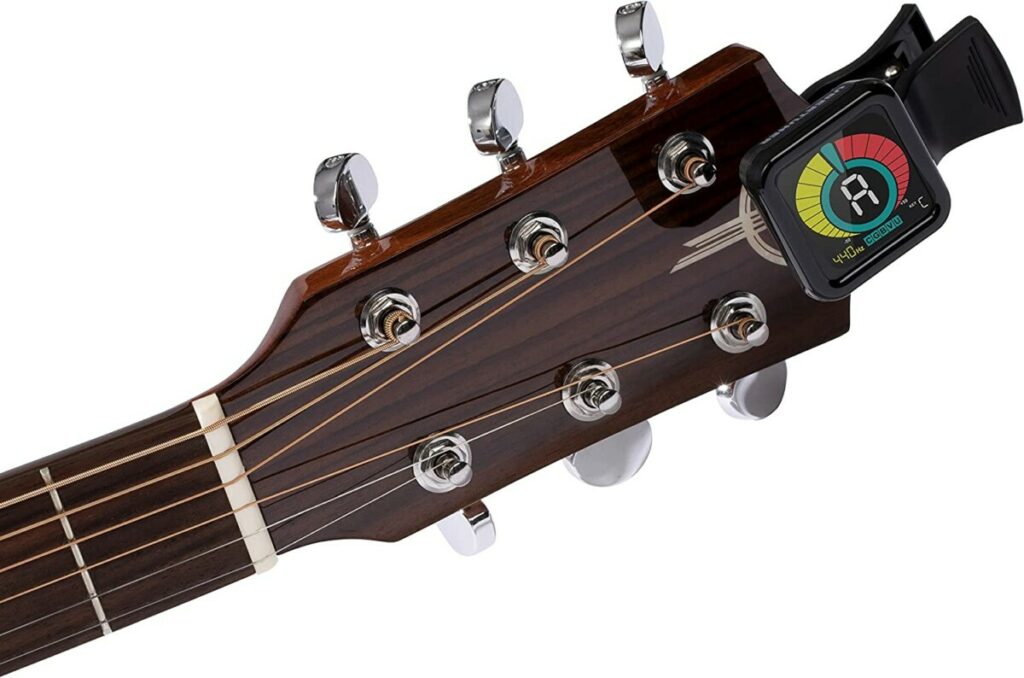Chromatic tuners are an essential tool for any musician looking to keep their instruments in tune.
Whether you play guitar, bass, or other stringed instruments, chromatic tuners can help you easily and accurately tune your instrument with minimal effort.
In this article, we will explore what chromatic tuners are, how they work, and the benefits of using one.
What Is A Chromatic Tuner?
A chromatic tuner is a device that helps musicians tune their instruments. It works by identifying the frequency of vibrations produced by plucking or striking the strings on an instrment and then displaying this information in Hz or cents (100ths of a semitone).
When tuning your instrument, you will need to adjust the pitch until it displays the desired frequency and the chromatic tuner will then show the output in either a numerical or chromatic scale, alowing you to visually check if your instrument is in tune.
It’s worth mentioning that personally I am a fan of clip-on guitar tuners, and there are plenty of clip-on chromatic tuners out there in the market.
How Does A Chromatic Tuner Work?

A chromatic tuner works by detecting the frequency of vibration of the strings on an instrument, typically through a microphone. It then displays this information in Hz or cents (100ths of a semitone). This alows musicians to understand what pitch they are playing at any given time and make adjustments as needed in order to achieve the desired note.
Where Can I Find Chromatic Tuners?
Chromatic tuners can be purchased from most music stores, but they are also widely available online.
When shopping for chromatic tuners online, it is important to make sure that you are buying one of good quality as this will ensure that it is acurate and reliable.
It is also a good idea to read reviews and check the specifications of any cromatic tuner before making your purchase in order to ensure that it meets your needs.
By understanding how chromatic tuners work, familiarizing yourself with diferent chromatic tuners available, and investing in one of good quality, you can ensure that your instrument always sounds its best. If you didn’t know and you’re a Mandolin player, there are also plenty of Mandolin tuners out there which you can check out.
Benefits Of Using Chromatic Tuners
The primary benefit of chromatic tuners is that they allow you to accurately tune your instrument with minimal effort, they are also more precise than traditional tuning methods and can be used in louder envirnments without being afected by background noise.
Additionally, chromatic tuners come in many forms, so you can find one that suits your needs, budget and preferences (more on them below).
In sumary, chromatic tuners are a great tool for any musician looking to keep their instrument in perfect tune and they provide an accurate way to ensure your instrument is always sounding its best and can be used in a variety of environments.
Whether you’re a profesional or just starting out as a musician, chromatic tuners are definitely worth investing in!
How To Use Chromatic Tuners Effectively?

To be honest with you, there are several methods to use chromatic tuners effectively and I want to share them with you in more detail.
As a start, you should always make sure that your chromatic tuner is corectly calibrated as this will ensure that it is acurately measuring the frequency of your instrument. Also, you should also try to familiarize yourself with how chromatic tuners work, so that you can easily adjust the pitch and make sure your instrument is in tune.
Lastly, keep in mind that chromatic tuners dont take into acount any natural variations in tuning between notes, also, if you want to make sure all your srtings are perfectly tuned, it is best to use an electronic chromatic tuner which can aid in more precise tuning.
It is also important to remember that chromatic tuners are not a substitute for practice or experience when it comes to playing an instrument, but they can be a great help in keeping your instrument sounding its best.
Different Types Of Chromatic Tuners Available
When it comes to the types of chromatic tuners, there are a variety of them available to suit diferent budgets and preferences.
The most common chromatic tuner is the clip-on chromatic tuner which attaches to the headstock of your instrument and uses a microphone or vibration sensor to pick up your instrument’s sound, these chromatic tuners tend to be more afordable, but can be less accurate than higher-quality models.
For those looking for a more precise chromatic tuning solution, there are electronic chromatic tuners that use an audio input signal and provide more acurate readings on the frequency of your instrument. The tuners generally come with aditional features such as metronomes and rhythm generators.
If you want a chromatic tuner that is both easy to use and precise, you can also opt for a digital chromatic tuner which combines the accuracy of an electronic chromatic tuner with the convenience of a clip-on model.
No matter what your budget or preferences are, there is sure to be a chromatic tuner that suits your needs.
Tips For Tuning Your Instrument With a Chromatic Tuner

Tuning your instrument using a chromatic tuner is a simple proces, but here are a few tips to make it even easier:
Make sure the chromatic tuner is properly calibrated: Before you begin tuning, make sure the tuner is properly calibrated to A 440 Hz, which is the standard pitch for most Western music.
Know your instrument: Each instrument has diferent tuning specifications, so make sure you know the standard tuning for your instrument. For example, a standard guitar is usually tuned to E-A-D-G-B-E.
Choose the right type of tuner: There are diferent types of chromatic tuners, such as clip-on tuners, handheld tuners, and smartphone apps. Chose the one that works best for your instrument and your preferences.
Know the notes you need to tune: Before you start tuning, make sure you know which notes you need to tune to. Some instruments have more than one string for each note, so make sure you know which string you need to tune for each note.
Start with the lowest string: Start by tuning the lowest string on your instument first and then move on to the next string. This way, you can ensure that each subsequent string is in tune relative to the one before it.
Pluck or strum the string: Pluck or strum the string you want to tune and adjust the tuning pegs or machine heads until the tuner idicates that the note is in tune.
Check intonation: Once you have tuned all the strings, check the intonation by playing a few chords or playing a melody. Make any necessary adjustments to ensure that the instrument is in tune throuhout its range.
Repeat the process regularly: Over time, the strings on your instrument will stretch and slip out of tune. It is important to tune your instrument regularly to keep it sounding its best.
By folowing these tips, you should be able to tune your instrument using a chromatic tuner with ease.
Conclusion
So, chromatic tuners are a great tool for any musician looking to ensure that their instrument is perfectly tuned.
I hope in this article you found everything you needed to know! So, take the time now to invest in a chromatic tuner and start exploring!

